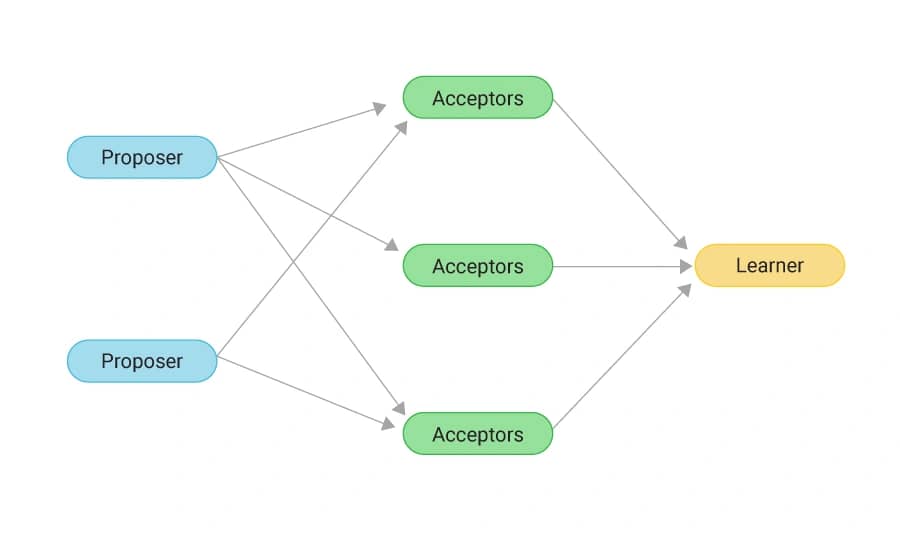Subscribe to wiki
Share wiki
Bookmark
Paxos Algorithm
We've just announced IQ AI.
Paxos Algorithm
The Paxos algorithm is a consensus protocol designed to achieve agreement among a group of distributed processes or systems, even in the presence of failures. It was developed to solve the problem of reaching consensus in a network of unreliable processors, making it fundamental to distributed computing and blockchain technology.
Overview
Paxos is a family of protocols for solving consensus in a network of unreliable processors. The algorithm allows distributed systems to agree on a single value or a continuous sequence of values, even when some participants may fail or messages may be lost. Paxos ensures safety (no two processes decide on different values) and liveness (a decision is eventually reached) under certain conditions[1].
The Paxos algorithm was first introduced by Leslie Lamport in 1989 and later published in 1998 in his paper "The Part-Time Parliament"[2]. The algorithm's name and initial description were presented as an allegorical system of legislators passing laws on the fictional Greek island of Paxos. This unique presentation initially made the algorithm difficult to understand, leading Lamport to publish a more straightforward description titled "Paxos Made Simple" in 2001[3].
Key Concepts
The Paxos algorithm involves three primary roles:
- Proposers: Nodes that propose values for agreement
- Acceptors: Nodes that accept or reject proposals
- Learners: Nodes that learn and act on the agreed-upon value
These roles are not mutually exclusive, and a single node can perform multiple roles.
Basic Paxos Protocol
The basic Paxos protocol consists of two phases:
-
Prepare Phase:
- A proposer selects a proposal number n and sends a prepare request to a majority of acceptors.
- If an acceptor receives a prepare request with n greater than any previously received prepare request, it promises not to accept any more proposals numbered less than n and sends the highest-numbered proposal (if any) it has accepted.
-
Accept Phase:
- If the proposer receives responses from a majority of acceptors, it sends an accept request to each of those acceptors for a proposal numbered n with a value v, where v is the value of the highest-numbered proposal among the responses, or any value if the responses reported no proposals.
- If an acceptor receives an accept request for a proposal numbered n, it accepts the proposal unless it has already responded to a prepare request having a number greater than n.
Variants and Optimizations
Several variants of the Paxos algorithm have been developed to address specific use cases and improve performance:
- Multi-Paxos: Optimizes the basic Paxos for a sequence of decisions by electing a stable leader.
- Fast Paxos: Reduces the number of communication steps in favorable conditions.
- Cheap Paxos: Designed to reduce the number of processors required for fault tolerance.
- Generalized Paxos: Allows for more flexibility in the ordering of commands.
Applications in Cryptocurrency Projects
The Paxos algorithm and its variants have found applications in various cryptocurrency and blockchain projects due to their ability to achieve consensus in distributed systems. Some notable examples include:
1. Tendermint
Tendermint is a Byzantine Fault Tolerant (BFT) consensus engine that uses a variant of the Paxos algorithm. It is used in the Cosmos network and other blockchain projects. Tendermint's consensus protocol is based on the DLS protocol, which is derived from Paxos[4].
Key features:
- Provides Byzantine Fault Tolerance
- Supports proof-of-stake systems
- Allows for fast finality of transactions
2. Hyperledger Fabric
Hyperledger Fabric, an open-source blockchain framework, uses a pluggable consensus mechanism that can implement Paxos-based algorithms. While the default ordering service uses Raft (a consensus algorithm inspired by Paxos), Fabric's modular architecture allows for the implementation of Paxos-based consensus[5].
3. Libra/Diem
The Libra (later renamed Diem) project, initiated by Facebook, used a consensus protocol called LibraBFT, which is based on HotStuff. HotStuff is a leader-based Byzantine fault-tolerant replication protocol for the partially synchronous model that incorporates several ideas from Paxos[6].
4. Algorand
While Algorand doesn't directly use Paxos, its consensus mechanism, called Pure Proof-of-Stake (PPoS), shares some similarities with Paxos in terms of achieving agreement among distributed participants. Algorand's protocol aims to provide the security guarantee of Paxos while improving on its performance and scalability[7].
Challenges and Limitations
Despite its widespread use, the Paxos algorithm faces some challenges:
- Complexity: The algorithm can be difficult to understand and implement correctly.
- Performance: In its basic form, Paxos requires multiple rounds of communication, which can impact performance in high-latency networks.
- Leader election: In Multi-Paxos, leader election can be a point of contention and potential bottleneck.
- Scalability: As the number of participants increases, the communication overhead can become significant.
Conclusion
The Paxos algorithm has played a crucial role in the development of distributed systems and has influenced the design of many consensus protocols used in cryptocurrency and blockchain projects. Its ability to achieve agreement in the presence of failures makes it a fundamental building block for creating robust and reliable distributed systems. As the field of distributed ledger technology continues to evolve, Paxos and its derivatives remain relevant in addressing the challenges of consensus in decentralized networks.
[1] Lamport, L. (1998). The Part-Time Parliament. ACM Transactions on Computer Systems, 16(2), 133-169. [2] Lamport, L. (2001). Paxos Made Simple. ACM SIGACT News, 32(4), 51-58. [3] Castro, M., & Liskov, B. (1999). Practical Byzantine Fault Tolerance. OSDI, 99(1999), 173-186. [4] Buchman, E., Kwon, J., & Milosevic, Z. (2018). The latest gossip on BFT consensus. arXiv preprint arXiv:1807.04938. [5] Androulaki, E., et al. (2018). Hyperledger Fabric: A Distributed Operating System for Permissioned Blockchains. Proceedings of the Thirteenth EuroSys Conference. [6] Baudet, M., et al. (2019). State Machine Replication in the Libra Blockchain. The Libra Assn., Tech. Rep. [7] Gilad, Y., et al. (2017). Algorand: Scaling Byzantine Agreements for Cryptocurrencies. Proceedings of the 26th Symposium on Operating Systems Principles.
See something wrong?
